Picture of a wart
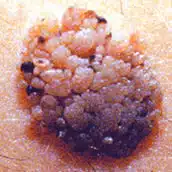
What Are Seborrhoeic Warts (Also Known as Age Warts or Brown Warts)?
Seborrhoeic warts — also called seborrhoeic keratoses, age warts, or brown warts — are very common, harmless skin growths that often appear as people get older. They are sometimes known as “stuck-on” skin growths because they look like they’ve been pasted onto the surface of the skin.
These growths can be greasy, waxy, crusty, or rough, and range in colour from light brown to very dark brown or black, depending on your skin tone and melanin levels. They can be flat or slightly raised, often round or oval, but some may have an irregular shape. Sizes vary from a few millimetres to several centimetres, and larger patches may contain clusters of multiple growths.
Seborrhoeic warts usually start to appear in midlife (often from your 40s onward), and become more common with age. They may run in families. According to the British Association of Dermatologists, about 30% of people over 40 and 75% of people over 70 have at least one seborrhoeic wart.
Although the exact cause isn’t known, many people develop several of these growths over time. They tend to darken and thicken slowly, but may eventually flake off, especially if they become brittle. Softer or fatty ones are less likely to fall off. Occasionally, a seborrhoeic wart becomes inflamed and drops off — but any inflamed or changing skin lesion should be shown to a doctor to rule out more serious conditions.
These growths can appear almost anywhere on the body, but not on the palms of the hands or soles of the feet.
Showcasing a couple of patients' results of shave excision of warts
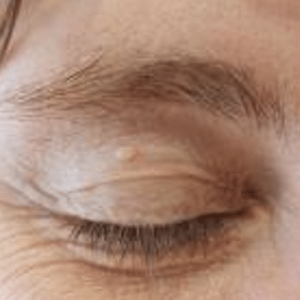
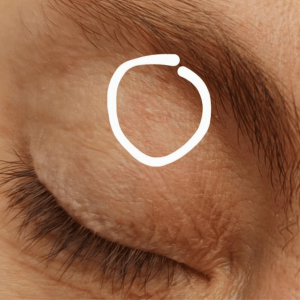
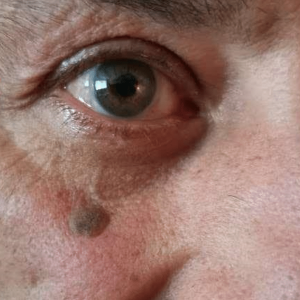
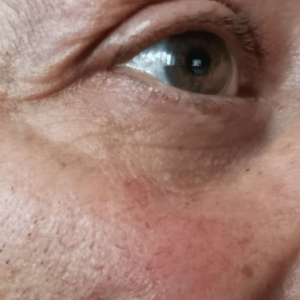
Is a Seborrhoeic Wart Serious?
No — seborrhoeic warts (also known as age warts, brown warts, or seborrhoeic keratoses) are not serious. These are benign skin growths, meaning they are non-cancerous and do not spread to other parts of the body. Many people choose to leave them alone unless they become irritating or unsightly — particularly when they appear on the face, scalp, or upper body.
Although they are often called “warts,” this is a bit misleading — they are not caused by a virus, and they are not contagious. They are also sometimes described as “stuck-on” skin growths because they appear to sit on the surface like they’ve been pasted on.
In rare cases, a form of skin cancer (such as melanoma) has been found in the same area as a seborrhoeic keratosis. This is thought to be a coincidence, rather than the seborrhoeic wart turning into cancer. Still, it’s important to see your doctor if any lesion changes in appearance, especially if it grows rapidly, bleeds, itches, or becomes inflamed.
Can Seborrhoeic Warts Be Treated?
Yes — seborrhoeic warts (also called age warts, brown warts, or seborrhoeic keratoses) can be safely and effectively treated, although removal is usually not medically necessary. If they aren’t causing symptoms, they can be left alone. Some may even fall off on their own, especially if they become brittle or inflamed — but any red, painful, or rapidly changing skin lesion should always be checked by a doctor to rule out more serious conditions.
That said, many people choose to have seborrhoeic warts removed for cosmetic reasons, or because they cause itching, discomfort, or snag on clothing or jewellery. They also often appear on the face, neck, back or chest, where patients may prefer to have them cleared.
Treatment Options
At Thames Valley Surgical Services, we offer several highly effective techniques. The best method depends on the location, thickness, and texture of the lesion, and we will always advise you on the most suitable approach:
DermaBlade Shave Excision
For thicker warts, we typically use a DermaBlade or curette to gently shave the lesion off after applying a small amount of local anaesthetic. This technique is quick, precise, and leaves minimal scarring.Fine Electrocautery, or Electrodessication
For thinner lesions, we may use heat- or light-based methods such as laser, cautery, or electrodessication. These methods are highly effective, and contrary to common belief, they do not cause more scarring. In fact, the lesion can often be softened and gently wiped away during the process.
We use specialist dressings where needed to support healing and reduce any risk of scarring. Once a seborrhoeic wart is removed, it sometimes comes back in the same place — new ones may appear elsewhere over time.
*Cost of Seborrhoeic Wart removal: £200
The cost for removal is usually £200 for a one, £25+ for any further wart depending on size and surgical difficulty. Click here for more detailed pricing. Please be aware laboratory cost and consultation are charged separately. The consultation is free for returning customers. Sometimes, particularly when you have multiple of these, we don’t have to charge a lab fee every time.
Further information
For further information have a look at this leaflet on patient.info
What about other types of warts?
If you have normal viral warts, please do not look into surgical removal. Trying to remove them surgically is often a waste of money. They can usually be on the hands, feet and lips (people chewing them). The best treatment for them is often waiting and / or Salicylic Acid preparations (I like Salactol).
According to research by the British Medical Journal all other treatments i.e. freezing etc are second or even third line treatments and only recommended in extreme cases. They are often also less successful than Salicylic Acid preparations.
The key about Salactol is to use it regularly for long enough. Many people use it for 1-2 weeks and then give up. However, the bodies immune system needs to respond and the wart needs to go a bit red and tender for it to actually disappear. Sometimes it take months for warts to respond. I have heard many occasions where patients, often children, had warts for years and then they disappeared all in a week. For further information look here.
Some other forms of warts, like Molluscum Contagiosum crop often in children and tend to disappear after 12-18 months by themselves.
More Information: For a glossary on minor surgery terms, click here
What next?
If you wish to make an appointment you can contact us or book an appointment online. Alternatively you can ask for a telephone consultationn. If you do so, please read the section “How TVVS works”, thoroughly. If you are worried about pain, please click here to see how we provide painfree surgery.
Accessibility & Clinic Location
Our clinic in Bourne End, Buckinghamshire offers easy access for patients across the South East of England seeking expert minor skin surgery and milia removal. We’re strategically positioned near major roadways and connected to London and surrounding counties via excellent public transport links.
📍 Nearby Local Areas (within 20–30 minutes)
Bourne End, Marlow, Henley-on-Thames, Twyford
Maidenhead, Windsor, Ascot, Slough
Gerrards Cross, Beaconsfield, Chalfont St Peter
Uxbridge, West Drayton, Egham
🚆 Easy Access via the Elizabeth Line (West & East London)
We’re directly connected to Central and East London via the Elizabeth Line, making travel fast and simple from:
West London: Paddington, Ealing, Acton, Southall, Hayes
Central London: Bond Street, Tottenham Court Road, Farringdon, Liverpool Street
East London: Whitechapel, Stratford, Ilford, Romford, Chadwell Heath, Shenfield
This makes us an ideal choice for patients looking for milia removal in London without long waiting lists or inflated city-centre pricing.
🛣️ Convenient from the M4, M40 & A404
Easily accessible from key regional towns including:
Bracknell, Reading, Wokingham, Staines, Virginia Water
Richmond, Twickenham, Northolt, Harrow, Wembley
Woking, Farnborough, Guildford, Basingstoke
🌍 Wider Regions (within 45 minutes to 2 hours)
Many patients also travel to us from:
Oxfordshire: Oxford, Banbury, Thame, Didcot
Buckinghamshire & Milton Keynes
South East counties: Surrey, Hampshire, Sussex, Kent, Essex
South Coast: Southampton, Portsmouth, Brighton, Eastbourne
South West: Swindon, Bath, Bristol
Even parts of South Wales, via the M4
🧭 Why Patients Travel to Us
Patients choose us from across the region for our:
Fast access with minimal travel time
Convenient online booking and flexible consultation options
Reputation for safe, efficient, and pain-free milia removal
Clarifying the Term: Seborrhoeic Wart
This section is here to clarify which types of warts we treat through this service. We do not treat viral warts (such as verrucas or common hand warts) — these are addressed separately under a different category.
The term “seborrhoeic wart” can be confusing, as it goes by many different names. All of the following terms refer to the same type of benign, non-viral skin lesion:
Medical / Clinical Terms
Seborrhoeic Wart
Seborrhoeic Keratosis
Non-Viral Wart
Senile Wart
Colloquial / Descriptive Terms
Brown Wart
Skin Wart
Stuck-On Wart
Stuck-On Mole
Age Wart / Old Age Wart / Wisdom Wart
Waxy Skin Growth
Crusty Brown Spot
Itchy Skin Patch
Skin Barnacle
Flat Brown Lesion
Rough Age Spot
Mole-Like Growth (not a mole)
Scaly Patch on Back or Chest
Despite names like “age wart” or “senile wart,” these growths are not limited to elderly patients. In fact, they often appear in young and middle-aged adults, and may run in families. They are especially common in Caucasian skin types and tend to increase in number with age.
